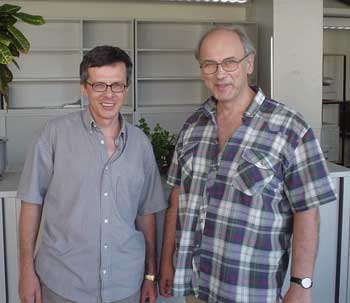| Posted: Nov 24, 2016 |
New capillarity effects in ideal gases solve an old mathematical mystery
(Nanowerk News) A Mathematician from the University of Leicester, Alexander Gorban, along with a physicist from ETH Zürich, Ilya Karlin, have challenged traditional concepts of micro and macro worlds and demonstrated how ideal gas unexpectedly exhibits capillarity properties.
|
|
In a paper published in the journal Contemporary Physics ("Beyond Navier-Stokes equations: capillarity of ideal gas"), they have paved the way to the solution of Hilbert’s 6th problem, a century-old mathematical mystery.
|
 |
| Professors Gorban (right) and Karlin
|
|
A glass of fluid contains billions of billions of moving particles (molecules). Each particle has its own trajectory and interacts and collides with other particles.
|
|
But how does the irregular motion of individual particles transform into the observable motion of a fluid? And how can we rigorously produce the equations of fluid motion from the equations of the microscopic motion? These questions form the important part of the famous Hilbert’s 6th problem.
|
|
In 1900, David Hilbert published a list of problems which influenced the development of mathematics for a century. Generations of mathematicians have tried to solve Hilbert’s problems, but a few remained unsolved. The 6th problem remains a big challenge for the scientific community.
|
|
Hilbert hypothesised that the problem is in the creation of a rigorous link between atomistic dynamics and the famous Navier-Stokes equations of fluid dynamics. Many big names in mathematics have tried to find conditions under which this link exists. So far, this link has only been established for infinitely slow and almost uniform fluid flows.
|
|
Gorban and Karlin in a series of works demonstrated that this is not the general case, and for the non-equilibrium flows the well-known equations should be corrected.
|
|
The formidable obstacle was known for long time: the formal procedure for obtaining the non-equilibrium corrections, the Chapman-Enskog series, results in non-physical equations in any post- Navier-Stokes order and, therefore, cannot be truncated at any step. The researchers found that instead they should use the whole infinite series. Gorban and Karlin applied this idea to kinetic models and produced new fluid dynamic equations.
|
|
“Ideal gases demonstrate these capillarity properties,” said Professor Gorban. “In high school textbooks and the popular science literature, capillarity is attributed to a liquid. How does capillarity appear in ideal gas? The answer to this question is in the nature of the interfaces between `bricks of matter’ used in the foundations of classical continuum mechanics.”
|
|
The possibility to represent the motion of a continuum as the flight of many infinitesimal parcels with soft, deformable but impenetrable boundaries is in the essence of the mechanics of materials.
|
|
Whenever the gradients of the hydrodynamic fields become comparable with the mean free path, there is an energy price to be paid for their maintenance. The highly idealised conventional picture of continuous media assumes an almost impenetrable elastic interface (Euler) with only a small smearing (Navier–Stokes). When the gradients increase, dispersion effects also come into play which is precisely what the surface energy is responsible for.
|
|
The results of Gorban and Karlin’s research can be considered as the negative answer to Hilbert’s 6th problem and brings insights to microfluidic and nanofluidic engineering.
|
|
Professor Gorban commented: “We are grateful to many researchers but especially important for this study were works of A. Bobylev, who proved singularity of the post-Navier-Stokes terms in the Chapman-Enskog series, and of M. Slemrod, who found capillarity in our solutions and encouraged us to continue our work.”
|
|
The work is a result of a long research program started in late 1980s in the Siberian city Krasnoyarsk, and continued in Leicester and Zürich.
|
|
Professor Karlin said: “We always joked in Siberia that it’s the edge of the civilized world, so you sit there and think of great problems.”
|

